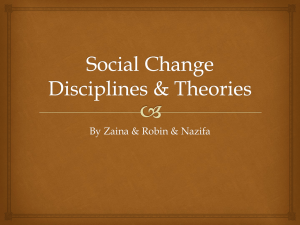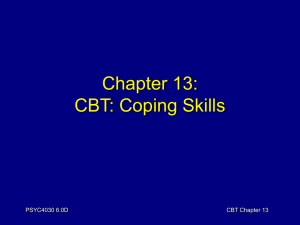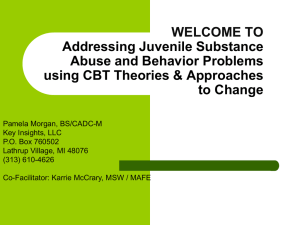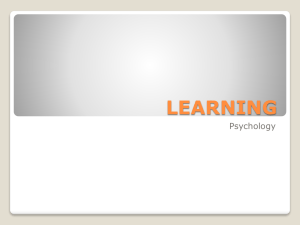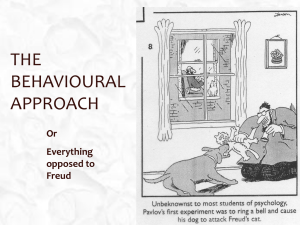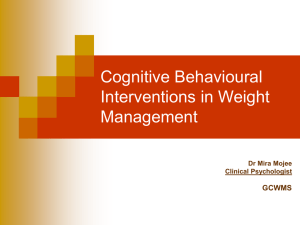Using Theories in Social Work
advertisement
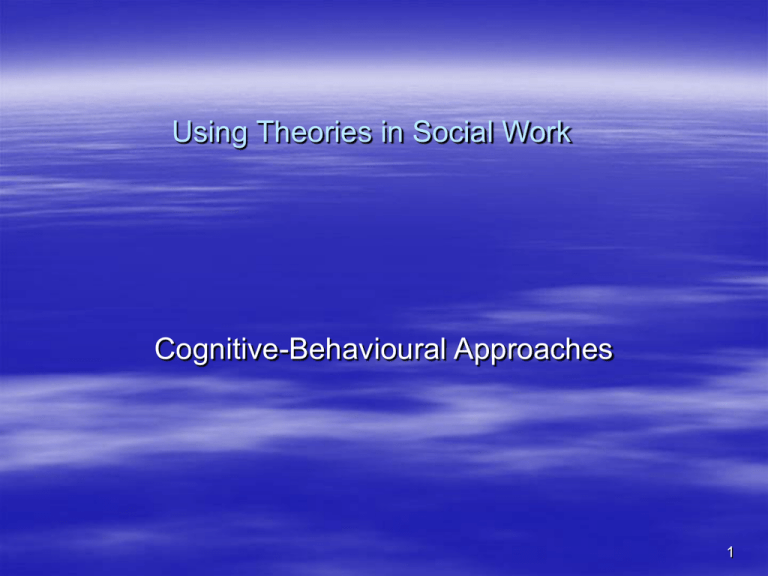
Using Theories in Social Work Cognitive-Behavioural Approaches 1 In order to comprehend these approaches – what do we need to know?: Some necessary background– psychological concepts – about how learning – particularly social learning takes place. First background to behavioural, and then second CBT approaches Problems with simple behaviourist approaches Explanation of what CBT is Some distinctions between different types of understandings of CBT Some indication of where and with whom these approaches work well – not always traditional social work settings Strengths and weaknesses of CBT Some concluding, summative thoughts Also will help if we use some interesting case studies – I will do this at appropriate junctures 2 a) Background to Behaviourism: Some Psychological Concepts about Social Learning Three main theories of social learning: Respondent or classical conditioning Operant, or instrumental, conditioning Social Learning Theory and modelling – more important for CBT – as it involves focus on cognition 3 1 Respondent Conditioning Presentation of food (Unconditioned response) Salivation Ringing of bell (Conditioned response) Switching on on of light Higher order conditioning 4 Classical Extinction Conditioned Conditioned Stimulus Response Conditioned stimulus gradually disappears when the unconditioned stimulus is removed 5 Example – Angry Driver Dangerous Driving incident (original stimulus) Paired/associated with Anger/Aggression (original stimulus) (conditioned response) Driving (conditioned response) 6 2 Operant, or Instrumental, Conditioning Anne cannot control her 7 year old, daughter Jasmine’s behaviour without resorting to physical slaps She has been referred to you Anne describes how Jasmine when shopping will scream and shout until she gets what she wants. She takes Jasmine out of the shops…buys her sweets…doesn’t work…..hits her legs…doesn’t work Now resorted to buying sweets as a bribe before going out Why do you think Jasmine’s behaviour is continuing? 7 For Jasmine clearly: Sweets are very desirable….and so the strong desire for them overrides any punishment so far offered Rewards strong; punishment weak Jasmine KNOWS she will always get what she wants in the end……. ………let’s diagrammatise an operant understanding of what is happening here 8 Operant conditioning – we don’t just learn through association with …rather we learn behaviours as a result of the stimuli that stimuli immediately follows their expression In other words we learn as a result of the consequences of actions rather than the stimulus that precedes them Operant conditioning Expression of behaviour (response) Crying Stimulus (consequence) Demanding Environmental Cue (antecedent stimulus) Shopping Other example of James and father 9 The different uses and aims of behaviour therapy – note focus on behaviour alone Tackling generalised conditioned responses – going out/get dirty; school phobias; etc Aim would be extinction of generalised response – taking child to school/park in stages – I used it with various phobias – spider phobia Some kinds of behaviour are incompatible with others – counter conditioning – associating desirable responses with particular stimuli Systematic desensitisation common technique – relaxation/personal support – e.g. transvestites/ agoraphobia/sexual therapy – reducing anxiety and therefore premature ejaculation; enuretic children 10 Ethics/politics of behavioural therapy In the 1960s there was a fearful debate about Skinner’s work – the behaviourist – notably in response to his book ‘Beyond Freedom & Dignity’ Principally critics were concerned about: The absence of concern for ‘the mind’ – the ghost in the machine The potential power that conditioning gave to the therapist to shape behaviour, and most importantly The potential power afforded to corporate and political power holders to condition their workforces/populations – cf Orwell’s 1984 and Huxley’s Brave New World Have any of you seen Stanley Kubrick’s Clockwork Orange or read the novel of the same name by Anthony Burgess? 11 Technical efficiency cannot override moral responsibility Certainly pure behavioural techniques can appear ‘nonhuman’ or inhumane There is a real problem as we are aware that some of our fears have been realised in some residential token economy, behavioural modification settings such the Pindown scandal They can smack of the imposition of values – cf manipulation Behavioural therapists argue that consent is always vital – and all therapy involves similar issues of limiting user choice – but what when consent is related to gaining privileges? 12 Background to CBT : Social Learning Theory and Modelling Background to these approaches can be found in the work principally, but not exclusively, in work of Bandura (1977) People’s learning is achieved through their perceptions and thinking about what they experience. They learn by copying the examples of others around them 2 sets of expectations: Outcome expectations – behaving in a certain way will produce a particular outcome Efficacy expectations – belief that the person has the capacity to produce successfully the behaviour necessary for achieving the desired outcome 13 Problems with basic learning theory - Bandura Difficult to always define what a person’s performance expectations are without close observation May have distorted view of our own efficacy – “I’m just no good at writing essays” Nevertheless, we can see where the change emphasis needs to be on reinforcement of positive thoughts to achieve desired outcomes 14 What is Cognitive Behavioural Therapy? Let’s start with a basic observation of an emotive episode that may happen to any of us Three elements: A What starts it off? B Beliefs about B C Reaction ANTECEDENT/ACTIVATING EVENT BELIEFS CONSEQUENCE Example A B C Friend passes us in street & ignores us “I’m not worth acknowledging”; “nobody gives a s…”; “seen as worthless as a friend…therefore as a person” Feelings - lonely and depressed Behaviour – withdraw into self So at root CBT is about: How you think about yourself, the world and other people How what you do affects your thoughts and feelings Self Action Unhelpful – Go home and avoid this friend and others Helpful – get in touch and see if they are ok 15 Related and building on learning theory – Cognitive Theory and Behavioural Work - CBT There are a range of related theories here – see Payne pp 121-123 – see also slide 19 Cognitive theory is basically suggesting that as behaviour is affected by perception or interpretation of the environment during learning Inappropriate behaviour must be a misperception The interesting issue here is that behavioural therapies or CBT are discussing altering disorders in thinking – in the MIND – when as we saw above initially behaviourism only focussed on behaviour 16 ABCs – Antecedent; Beliefs; Consequence We can see that the basic tool deriving from these approaches for practical work by psychologists & social workers is this use of A, B, Cs In terms of a basic tool kit that has a hands on utility – then these behaviour therapy approaches are now widespread in contemporary NHS and social care work Widespread use in work on: Stress/anxiety; depression; addictions; panic; agoraphobia & other phobias, social phobia, bulimia, obsessive compulsive disorder; post traumatic stress disorder and, now, in some cases schizophrenia Huge recent investment by NHS – see below 17 Classification…4 types of cognitive-behaviour therapies – according to Scott & Dryden (1996) Coping Skills – 2 elements self verbalisation (instruction to ourselves) & changes to environment e.g. stress reduction Problem solving – cf Perlman’s psycho-analytic work – see life as a process of resolving life issues lock onto a problem generate a no of solutions – get client to choose best for them Cognitive restructuring – particularly used when people are unreasonably negative – ‘awfulising’ – as Ellis calls it in his rational-emotive beh.therapy technique…..irrational beliefs at the root of people’s problems e.g. lorry driver – see below Structural cognitive therapy – concerned with 3 ‘structures’ of belief - core beliefs; intermediate beliefs or explicit descriptions of the world; and peripheral beliefs. The later are used as become the immediate target of 18 action but the aim is to alter the other two Ellis’s ABCDE theory of emotions – cognitive re-structuring A B C D E Activating event of situation – wife dies unexpectedly Beliefs – self defeating belief – “my fault should have called GP earlier”! Consequences – emotional/behavioural - “I deserve to suffer/be depressed/don’t need/deserve help Disputation – challenge irrational belief and replace with rational – “you did right and do not have power over life and death.” Evaluation – goes alongside D – so that the client reappraises the A, B, C process 19 Effectiveness of CBT Strengths Evidence based practice - & examples of success in certain contexts i.e.with addictions & stress Relatively easy to use – but need to know techniques well & have good listening & presentational skills Widely applicable Time limited 20 Possible Problems with Use of CBT: Can be a long process – 5 to 20 one hour sessions Favourable outcomes when compared to no intervention or on subjects who select this therapy through public advertisements – much less so on random clinical selection Example - used a great deal for depression but in Nat Inst of Mental Health Study of depression – CBT fared less well than interpersonal therapy or GP management with anti-depressants Can be difficult for some patients to verbalise their feelings Does not really address the causes of problems Danger when CBT is used for clients that have more complex underlying psychiatric disturbances e.g. anger management progs in prisons Increasingly seen as a panacea in treating certain conditions cheaply 21 Conclusion Very wide influence in & around social work – particularly, but not exclusively, in mental health settings Usually used by social workers in a stripped down form around ABCs Fits in with task centred, focussed approaches planned, clear agreed goals Many elements of the practice can show empirical validated success Continues to generate some concerns due to its overly technical rational scientific nature, certain ethical issues & occasional inappropriate application 22
